What’s the best way to lure in new visitors? With saffron buns, of course. Or, lussekatter, as we often call them in Sweden.
At least, that’s the trick that Skansen pulled when it wanted to establish its new Christmas market in 1906.
You see, the situation for Christmas markets was serious. A senior police officer complained that the Christmas market at Stortorget in Gamla Stan in Stockholm offered “foreign trash” at steep prices, and gathered pick-pockets and “disturbing elements”. Nowadays, it might sound strange that such an institution has been threatened, but the complaints saw the market abolished for several years at the beginning of the 20th century.
Anyway—Skansen to the rescue. With its steady will to preserve Swedish traditions and customs, Skansen expanded its Christmas market. An article waxes lyrical about all the beautiful handicraft objects—handmade candles, dolls, and Christmas goats.
The sweet treat section was just as impressive. There were Christmas breads with “their special looks and funny names”, such as “Lussikatt [lussi-cat], Guldvagnar [golden wagons], Guldhönor [golden hens], såkakor [sowing breads]”—apparently no less than twelve different kinds, “baked after old shapes”.
Did Skansen manage to attract visitors just because of the stunning saffron buns? Regardless, even now when Stortorget’s Christmas market has been back for many decades, Skansen’s Christmas market is still a tradition for many.
You can ponder the appeal of the lussekatt, while you see how they are made, in stop motion:
Skip straight to the recipe for saffron buns by clicking here.
The history of saffron buns in Sweden
According to Carl-Bertil Widell in En sockerbagare här bor i staden, the celebration of Lucia in Sweden doesn’t have as much to do with the Italian saint from Syracusa, but German Christmas traditions. Jan-Öjvind Swahn mentions that this German model, “Christ-kindelein”, was accompanied by a devil figure. This apparently gave the bread its older name, “döfvelskatter”, meaning “devil cats”, an expression seen in Swedish for the first time in the late 19th century. With time, they were referred to as lussekatter, or lussikatter instead.
Professor Nils Ahnlund shares in 1937 how the German baker Martin Kammecker moved to Stockholm in 1646. Kammecker started his business and became well-known as the German baker, leading to the street name Tyskbagargatan which still exists—German Baker Street. According to Ahnlund, Kammecker introduced the saffron buns to Sweden.
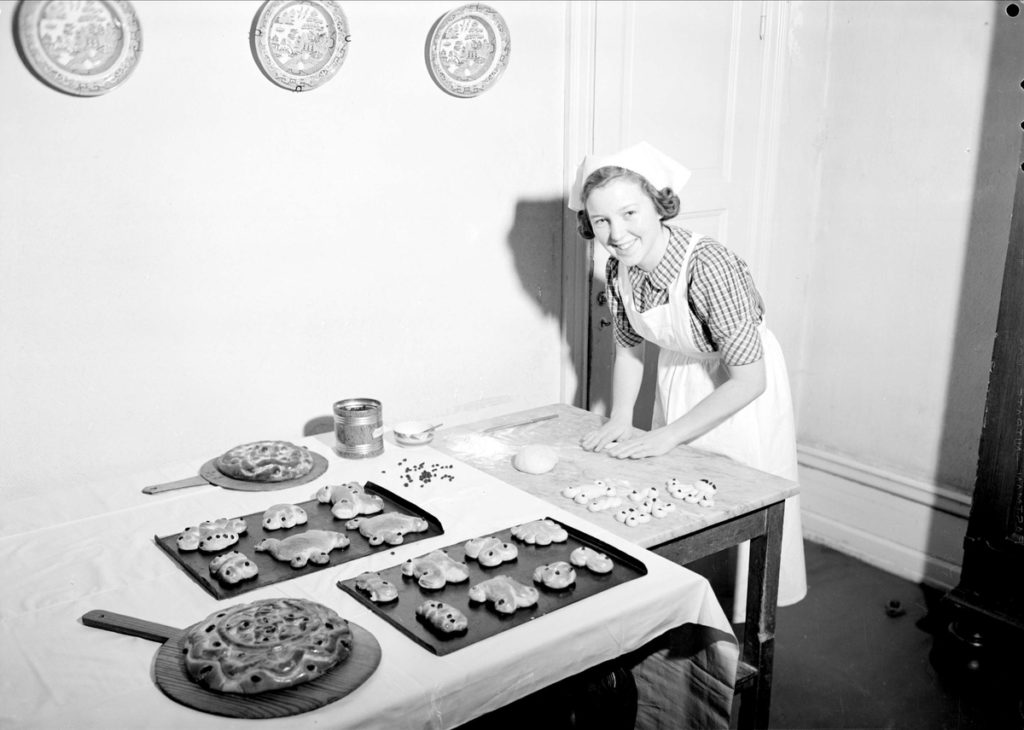
Nowadays, the saffron buns is connected to the Lucia-day on the 13th of December and the time around Christmas. In the past, it seems like it has been eaten at other times, too, for example at funerals. Saffron buns appear in articles and notices in Svenska Dagbladet around the year. For example, Chevalier writes in 1913 how the ladies get ready for kafferep, coffee parties, after returning from their summer stay in the countryside. Apparently, a good party had coffee with saffron buns and cookies, “preferably from one of the towns better bakers and, yuck, not with coconut butter”.
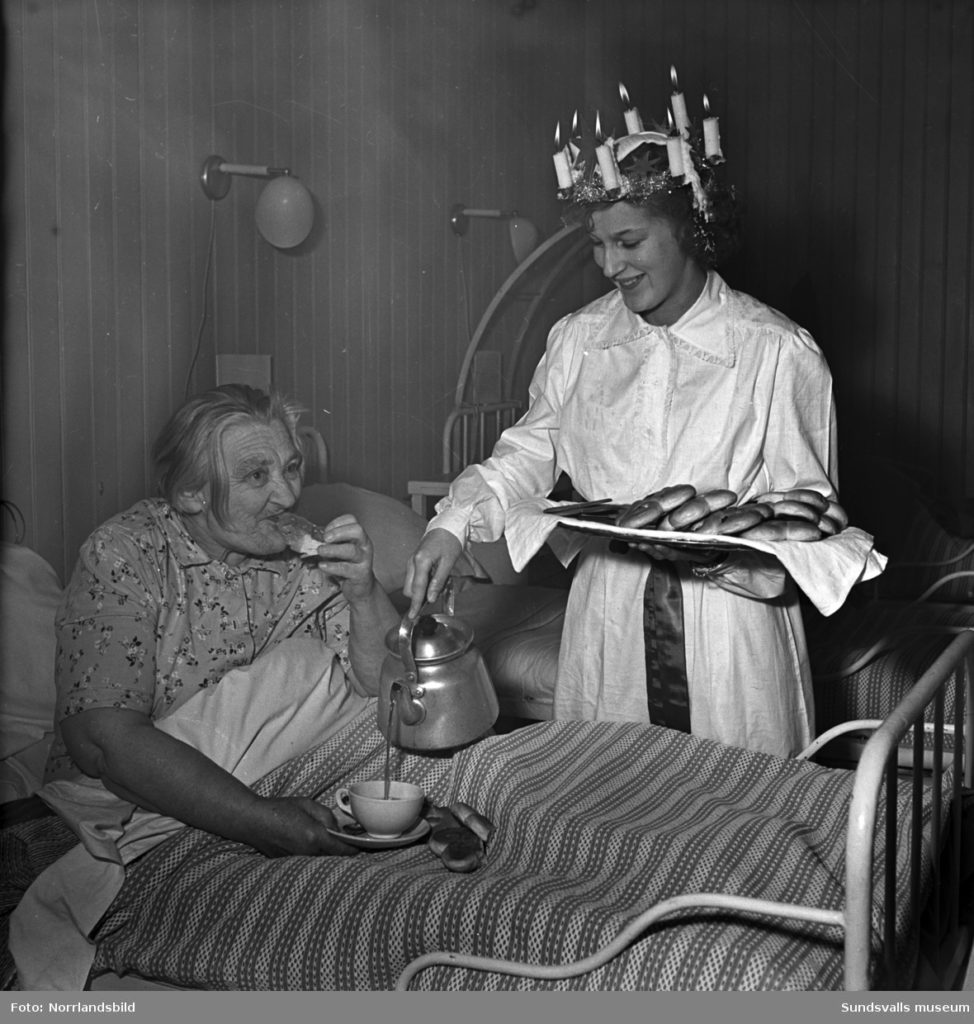
Not the same Lucia celebration as today…
At the end of the 18th century, people started celebrating the day of Lucia in a way more similar to today’s. Well, at least if you compare it to the previous food- and drinking parties that were before the Lent before Christmas started. The new Lucia didn’t have candles in her hair yet, but was dressed in a long dress and served food and schnapps. However, when the students at the universities in Uppsala and Lund became fond of the celebration, the sobriety associations relaunched Lucia as an innocent, angel-like light-bearer. Lucia came with coffee and buns instead of alcohol.
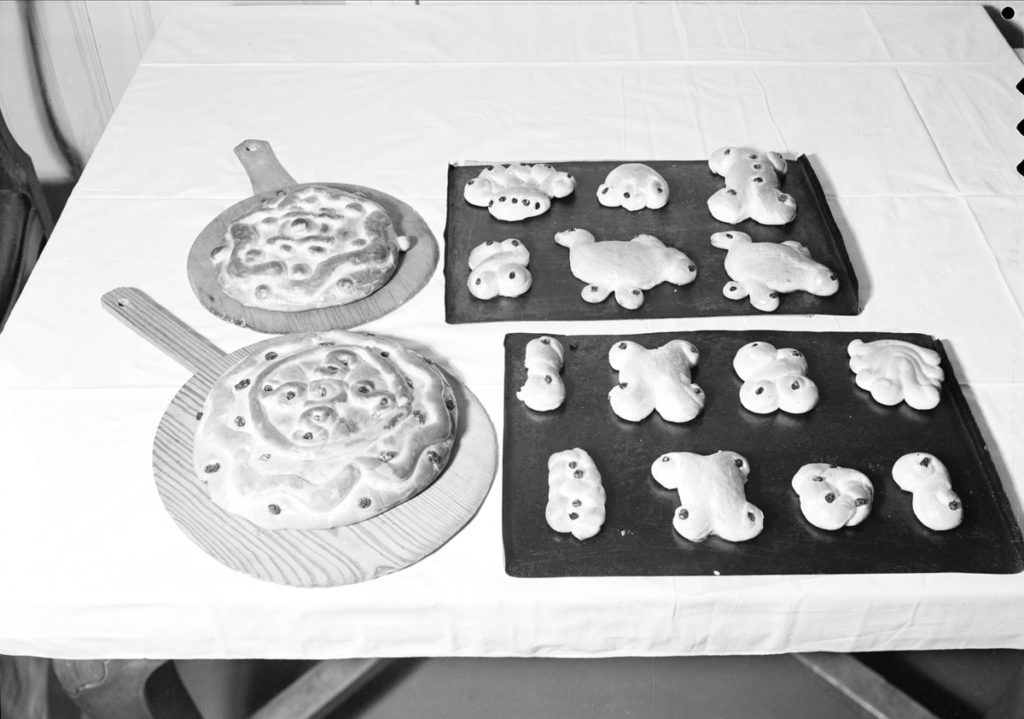
The many shapes of Swedish saffron buns
The saffron buns that most Sweds call lussekatt (lusse-cat)was originally called lussegalt (lusse-pig) eller julgalt (Christmas pig)—a pig instead of a cat! This is evident in old cookbooks such as Stora kokboken (1946).
There’s a lot of symbolism in the Christmas bread. Some shapes have religious meanings, such as prästens hår (the vicar’s hair) and kyrkporten (the church doors). Others, such as julgalten above, expresses a wish for abundant supplies of food. Gullvagnen, julvagnen or julkakan are all names for buns that refer to the sun wheel’s journey over the sky. Pojken, the boy, expresses hope for fertility.
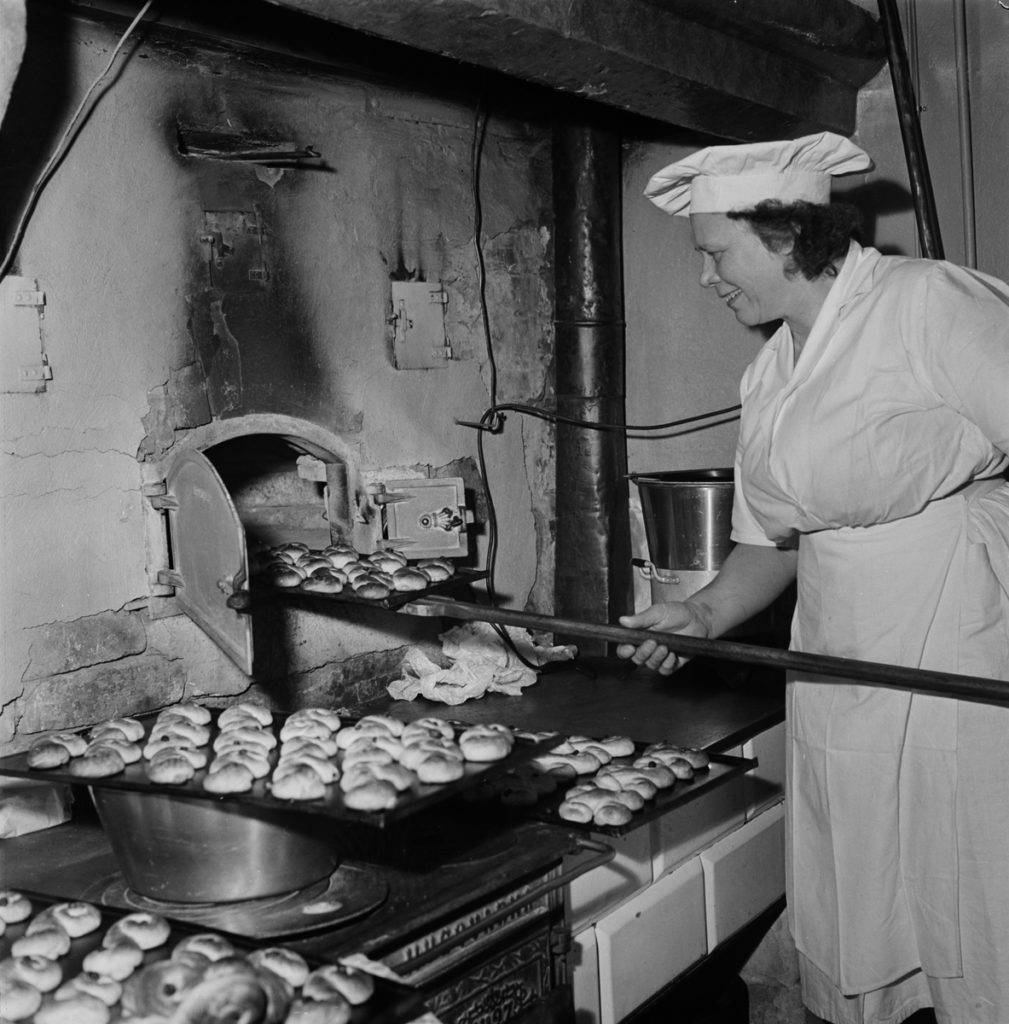
So how do you bake great saffron buns, or lussekatter?
After many tests, I come with the following recommendations:
1. Use butter of room temperature
A search in Svenska Dagbladet’s archive shows that it has been popular to add kesella, a type of kvark, to the dough of saffron buns at least since the beginning of the 1990s. But does it really make the dough better? Skip the kvark, or melting the butter, and instead add butter of room temperature in the dough. This way, you need less flour and get less dry buns.
2. Soak the raisins
The raisins that are used for garnish easily become dry or even burnt in the oven. I skip the problem by pouring the juice of a squeezed orange into the bowl of raisins when I leave the dough to prove. If you want to add raisins into the dough itself, you can of course soak the raisins even earlier. Water works well, too, but I enjoy the additional orange flavor.
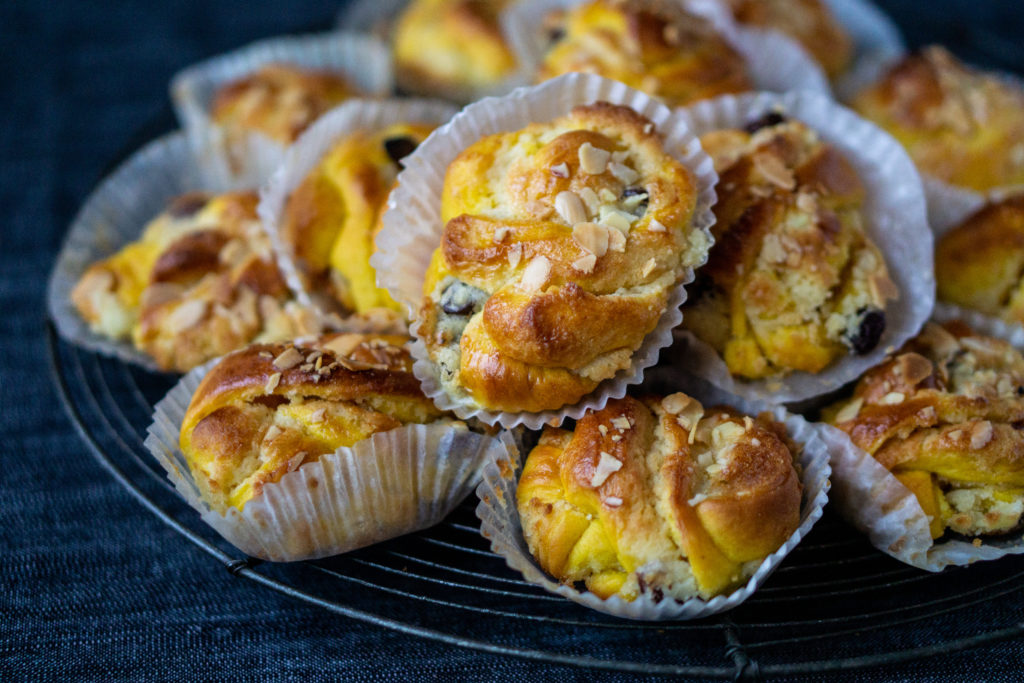
3. Fill the saffron buns
The poor bun we call lussekatt doesn’t have a chance. A plain bun just doesn’t get the same help from added butter that a filled bun does. So, yes, my shameless suggestion is that you don’t bake more lussekatter than you can eat in a day. Eat and enjoy (or by my all means put some in the freezer). Roll the rest of the dough out, and fill it with butter, almond paste, and soaked raisins. Shape to buns the way you do with cinnamon buns. These buns stay moist far longer than the poor cat-bun.
4. Soak the saffron
I add the saffron in a couple of tablespoons of cognac a few hours or even the day before baking, as I find that it strengthens the flavor. Of course, you can skip the alcohol and mix the saffron with some warm milk before you start baking.
5. Use “vetemjöl special”, protein-rich flour, if you have
Protein-rich flour means finer, higher buns.
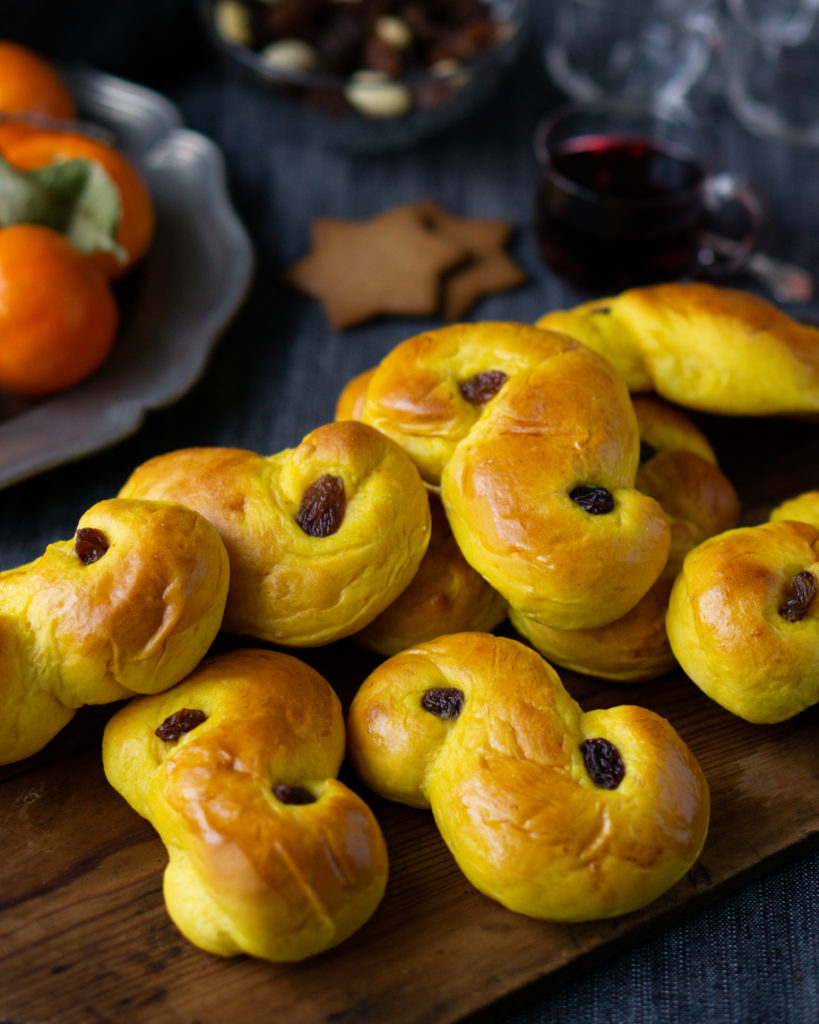
How to make luscious saffron buns
The almond paste helps the buns stay fresh even longer. Makes 25-30 buns
1 gr saffron
2 tbsp cognac, rum, or vodka (or milk)
5 dl (2 cups) milk
50 gr (1,8 oz) fresh yeast
1 1/2 dl (3/5 cups) sugar
1 tsp salt
13-14 dl (5-6 cups, possibly somewhat more) flour, preferably a protein-rich one like vetemjöl special
150 gr (2/3 cups) butter, room temperature
Decoration: raisins and orange juice or water, 1 egg
To make filled buns: 200 gr (7 oz) almond paste (or grind almonds and sugar 50/50), 200 gr (7 oz) room-temperature butter, a little vanilla powder, possibly some almond flakes, chopped almond, or pearl sugar
- Mix the saffron with 2 tbsp of cognac or other alcohol and leave it for an hour, or preferably overnight. If you don’t want to use alcohol, use some warm milk instead and let it steep for a while before starting to bake.
- Heat the milk until it is finger-warm. Be careful so it is not too warm, as that will kill the yeast.
- Crumble the yeast into a bowl, preferably of a kitchen mixer, and add some of the milk. Stir until the yeast has dissolved.
- Add the rest of the milk, saffron, sugar, salt, and about 5 cups of the flour.
- Run the kitchen mixer for a few minutes or knead until you get a loose dough. Add the butter and a bit more of the flour. Run the mixer for 5-8 minutes more until you have an elastic, loose dough that lets go of the mixing bowl but still is a bit sticky.
- Cover the dough with a clean kitchen towel and leave it to prove in a place free of draughts, for about 45 minutes or until it has doubled in size.
- While the dough proves, soak the raisins in orange juice, water, or whatever you prefer. If you want to make filled buns, grate the almond paste and mix it with the butter and a little vanilla powder until you have a smooth paste. You can do this in a kitchen mixer.
- Add a bit of flour to a work surface and knead the dough gently.
- To create the classic s-shape, dough the size of a ping-pong ball is generally good. Of course, you can make your own lusse-figures, but remember that the dough increases in size when it proves. Squeeze out excess liquid from the raisins and decorate as you see fit.
- To make filled buns, roll out the dough and spread it with the almond-butter filling. Squeeze out the excess liquid of the raisins and scatter them on top. Shape the dough into buns, for example by rolling it into a log and cutting it into snails, or folding it in half and cut stripes that you twist into buns. Use paper baking molds if you have.
- Regardless of shape, let your buns prove for about 30 minutes under a kitchen towel. Set the oven to 225°C (435°F).
- Whisk the egg with a little water and brush it over the buns. If you’re making filled buns, feel free to decorate them with almond flakes or something similar.
- Bake for 5-9 minutes depending on size until they get a little bit of color.
- Eat and enjoy! Remember that unfilled saffron buns are best the day they are made, so freeze whatever you won’t eat the same day.
Suggestions
Vary the filling for the filled buns as you wish — maybe adding some candied orange peel or succade would be nice?
Some choose to mix the raisins straight into the doughs of lussekatter. If you do, it’s extra important that they are soaked, so they don’t steal the liquid of the dough and make it dry.

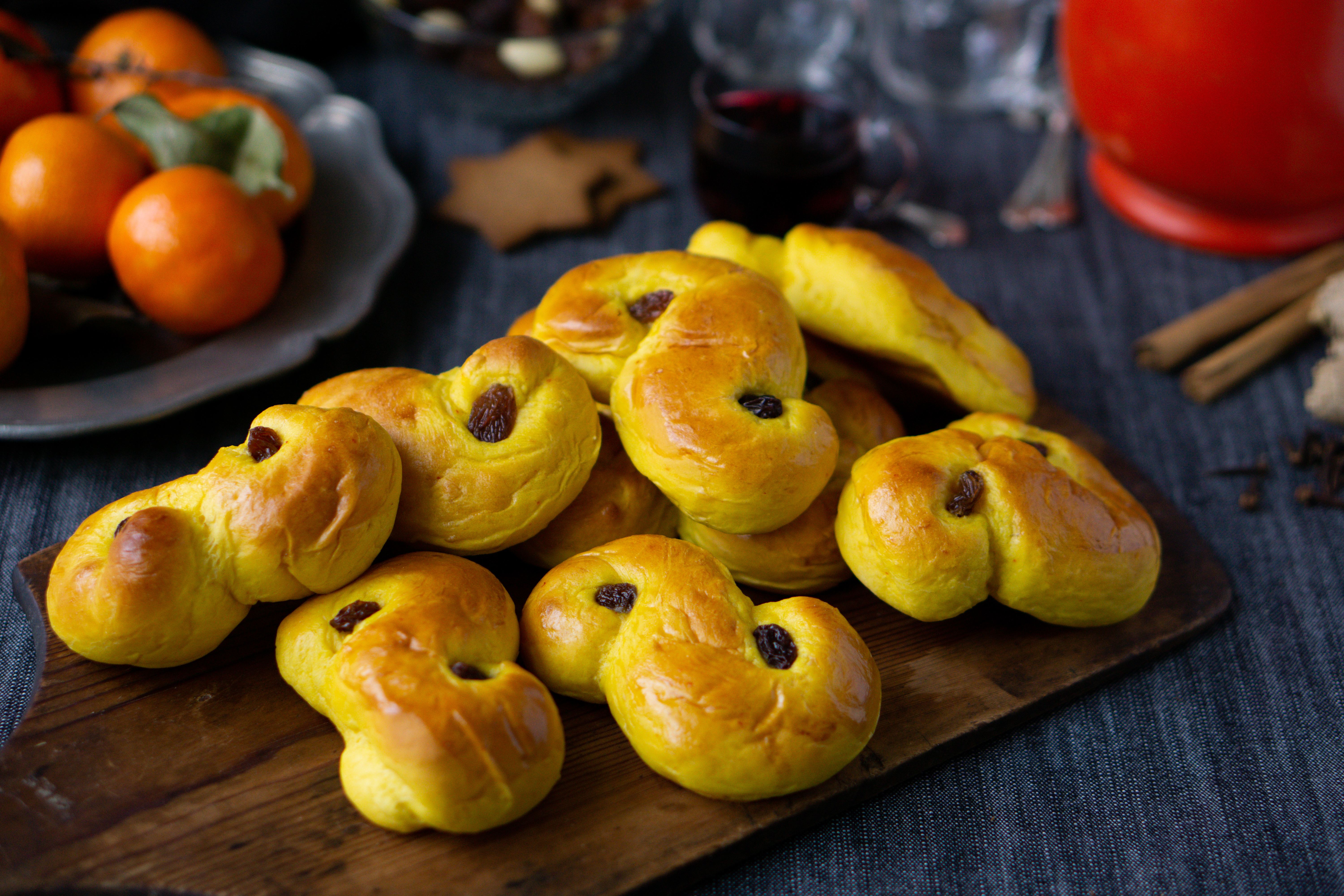

Thanks Isabelle for this great article, I love how you include history and old photos along the recipes! I’ve just picked up some saffron buns from my local IKEA this morning (I know :)) but I can’t wait to try your recipe for the real thing!
Oh, thank you so much, Erika! I do my best to scout out things in the old archives, there are so many weird and fascinating things to learn… Hope you enjoyed the saffron buns!